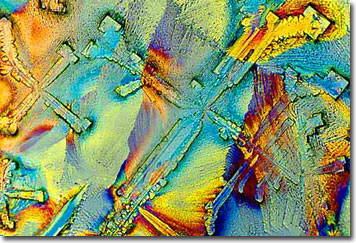Loes Modderman
Lithium, Guanidinium, and Potassium Chlorides
Lithium is a monovalent alkali metal related to sodium and potassium, but is much more deliquescent and is very soluble in water, alcohol, and ether. The second crystal featured in this image, guanidinium chloride, occurs biologically as a neurotoxin and geologically as a mineral that is susceptible to structural changes under pressure. Diet salt (potassium chloride) is thrown into the mix for contrast in this artistic composition. In addition to substituting for table salt (sodium chloride) targeted at sodium-sensitive people suffering from hypertension, diet salt also provides valuable cationic potassium for improving water and electrolytic balance.

As a hygroscopic solid, lithium chloride forms white crystals that readily absorb water from the air. In addition to its use as a psycho-active agent, lithium chloride is employed in air conditioning and welding, for salt baths, and in the production of soft drinks and mineral waters.
Guanidinium cations are often employed as ion-selective electrodes, as carrier reagents, and as buffers in a host of biochemical investigations. In the body, guanidinium compounds exhibit an inhibitory effect on the binding of ATP molecules in the pancreas, thus interfering with digestion. They also form extremely tight bounds to the sodium channels on the surfaces of nerve cell membranes, effectively shutting down any signal. As natural, potent neurological poisons, guanidinium cations are featured in toxins such as tetrodotoxin, produced by the notorious puffers. Tetrodotoxins are stored as anti-predator protection by some species of octopi, gobies, starfish, flatworms, sea snails, and marine algal species. In Japan, sushi chiefs who wish to prepare Fugu must go through years of training and are licensed by the government. A single milligram or less of tetrodotoxin (the amount that fits on the head of a pin!) is enough to kill a full-grown person in as few as 20 minutes and is considered 100 times as lethal as a venomous black widow spider bite and 10,000 times deadlier than cyanide.
Diet salt, usually composed of potassium chloride, is recommended for people that are hypertensive or otherwise require a sodium-free diet. Although sodium is a mineral that is needed throughout the body for proper functioning, using table salt (sodium chloride) as a spice added to food and drink is not always the best idea. Even on a regimented, salt-restricted diet, people still obtain some sodium from natural products such as milk, beets, celery, and drinking water. Processed food products such as Worcestershire sauce, onion salt, soy sauce, garlic salt, bouillon cubes, pretzels, popcorn, and potato chips have table salt added. Other major dietary sodium sources are monosodium glutamate, sodium nitrite, sodium benzoate, sodium bicarbonate, and sodium saccharin used for additional flavor or preservation in processed foods. In this fast-food nation, it is very difficult for a person to totally restrict their sodium intake, but it is possible modulate the amount consumed with the help of diet salt.
BACK TO LOES MODDERMAN GALLERY
